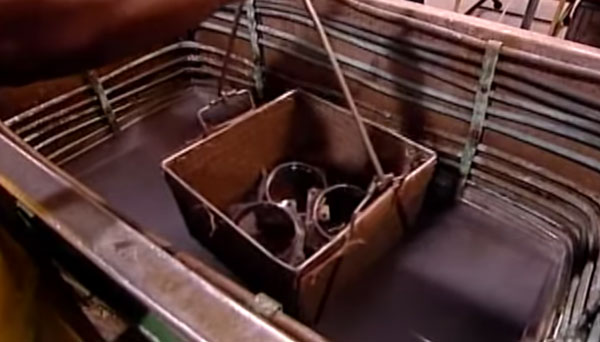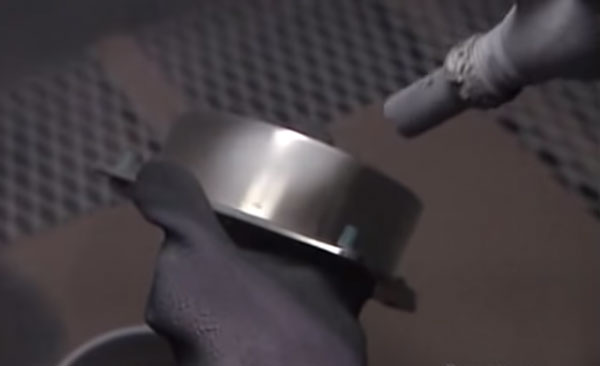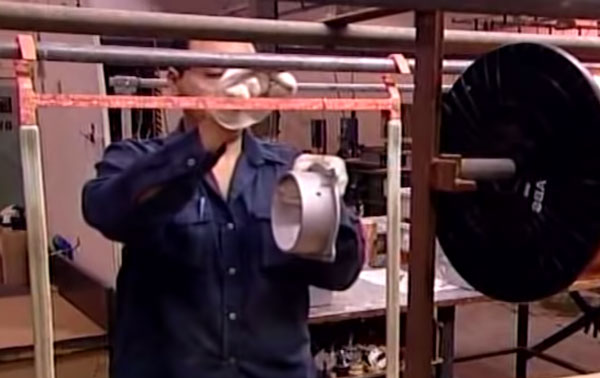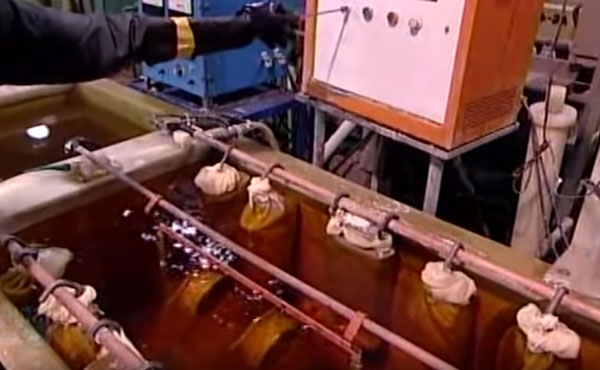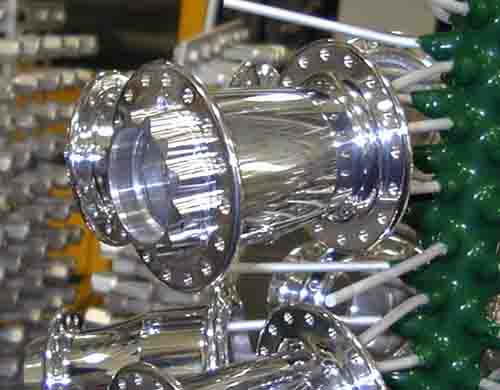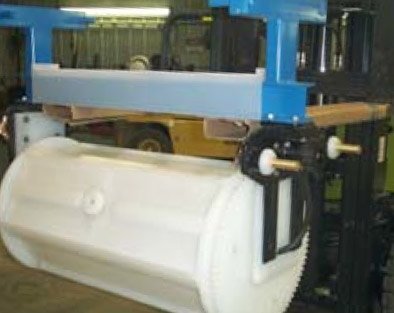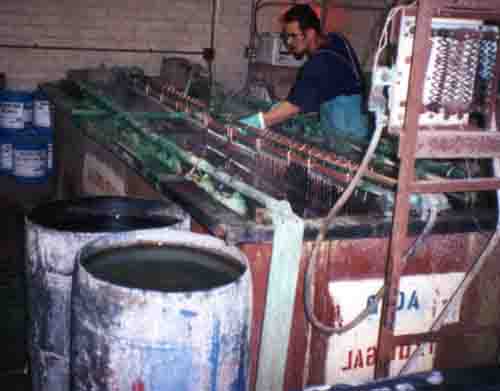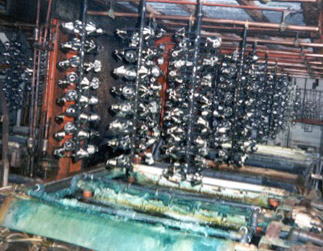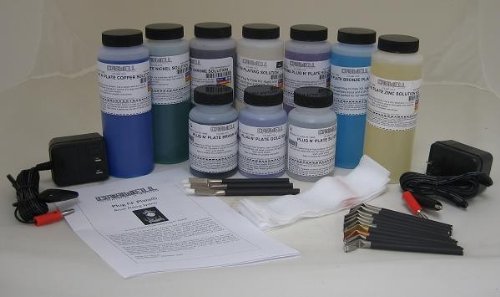The metal plating process involves creating an outer coating of nickel, copper, chromium or other metal to inhibit corrosion or to enhance the appearance of the parent metal.
It is usually done by immersing the metal in an acid solution with an anode electric current and cathode.
The material to be plated is made the cathode (negative electrode) of an electrolysis cell through which a direct electric current is passed.
The solution or bath contains the required metal in an oxidized form (either as a complex ion or aquated cation).
The anode is usually a bar of the metal being plated.
During the electrolysis process, the metal is deposited on the work and the metal from the bar dissolves. The process is governed by Faraday’s law of electrolysis.
The electroplating process causes the plating material to deposition on the parent metal.
Electroplating is used for:
- Appearance or for decoration
- Protection
- Special surface properties
- Engineering or mechanical properties
You can plate almost any type of metal. Zinc or cadmium plating prevents rusting while nickel and chrome protect against wear. Zinc, chrome and nickel are the most common industrial plating metals.
Metal Plating Process Video
History
In 1805 the Italian chemist Luigi Brugnatelli successfully electroplated silver medals with gold. The inventions were kept secret by the French Academy of Sciences. 35 years later electroplating was “re-discovered” by Russian and English scientists working independently.
In 1940 the first patent for electroplating was awarded. Factories in England started to mass-produced solver plated items such as utensils, brushes and teapots.
Metal Plating Process Components
Cleaning and Metal Surface Preparation:
- oxide removal
- electropolishing
- alkaline cleaning
Metal Plating (see below for descriptions):
- electroless plating (autocatalytic)
- electroplating
- Immersion plating
Finishing and Protection Treatments:
- phosphating
- chromate conversion
- anodizing
Typical Steps in Electroplating Process
The process shown below takes about 90 minutes to complete. This is the process for plating steel aerospace parts with cadmium.
- Cleaning: the surface must be free of contaminants for bonding to take place.
Suspended parts in a vat of boiling chemical solvents. The hot vapor comes in contact with cold metal and condenses, dripping down into vat along with any contaminants, leaving the parts clean and dry. - Rinsing and dry (if needed)
- Acid cleaning and etching: Sandblasting with aluminum oxide will roughen up the surface so that the plating metal adheres better.
Sandblasting parts with aluminum oxide powder to etch the surface and improve adherence of plating metal - Rinsing (if needed)
- Conversion Coating or Plating
Hanging part to be electroplated on the copper frame. Copper Wire suspends part from top and continues to bottom creating an electrical circuit through the part to be welded. The electroplating tank is filled with water and chemicals to help conduct electricity. The sides of the tank are lined with bags or balls of the plating metal. The support frame holding the part is connected to a negative terminal of the electrical source. The metal that is to be plated is connected to the positive terminal. A DC current of up to 6 volts dissolves the plating metal which travels through the water, attaching to the negatively charged piece to be plated. The process can take just a few minutes for thin plating to several hours for thick plating. - Water Rinsing (1 minute)
- Chemical Rinsing to make parts more rust resistant
- Rinse in Hot Water
Types of Plating
Electroplating (electrolytic plating)
The process that uses electrical current to drive the chemical reaction by reducing metal ions. Enables control of the plating process.
Autocatalytic (electroless plating)
In the autocatalytic process, a chemical reaction induces metal atom reduction. It uses non-conductive substrates and the process does not require electricity. It is difficult to control plating parameters and the plating bath has a limited lifetime.
This is referred to as a conversion coating process. Examples of conversion coatings are:
- Iridite on aluminum
- black oxide
- chromate
- phosphate
The conversion coating process will add dimensional growth to thickness but does not create a direct relationship since the process consumes some of the substrate metal.
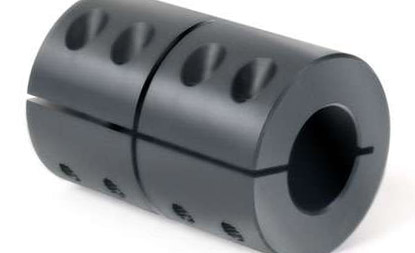
Immersion Plating (Displacement reaction)
In this process, the metal ion is reduced from solution by exchange with a metal atom from the substrate. The metal deposited must have more Electromotive Force than the metal that was dissolved.
Applications
- Surface Protection (also called anodic coatings or sacrificial coatings): to protect the base metal, primarily used over iron and steel.
- Decorative Coatings: these make the metal more attractive and provides some level of protection.
- Engineering coatings: used to impart a specific property to a surface. Examples include surfaces to increase solderabililty, conductivity, reflectivity and others.
- Minor Metal Plating: limited number of metals that do not have many applications.
- Unusual metals: metals that are electroplated under special conditions.
- Alloy metal plating: also for specialized applications.
Plating Methods
Rack Plating Method
Rack plating is the most commonly used method where the metal to be plated is hung on a frame or rack. It is a versatile method that provides control over rinse water and drag-out rates.
Barrel Plating
Barrel plating occurs in a closed barrel. The process is used when electroplating smaller parts or there is a lower level of processing requirements/standards. The rinse water use is high and drag-out rates are high as well.
Manual Plating
In manual metal plating everything is performed by a trained technician. It is for small batch plating.
Automated Plating
Key Chemicals
Acids and Bases:
- HCL
- Caustic
Coatings:
- Cyanide
- Chromium
- Cadmium
- Silver
- Gold
- Brass and bronze
- Zinc
Solvents:
- Benzene
- TZE
- Trichloroethylene
- Methylene chloride
- Tetrachloroethylene (perchloroethylene)
Environmental Corrosion Testing
Metals are testing in the environment to determine if the method of electroplating will protect from corrosion. The challenge is to simulate the time it takes for corrosion to occur, which is why several types of tests that simulate the passage of time have been developed.
In some cases, an organization will set up indoor or outdoor exposure stations. Other approaches are to apply test metals to surfaces that are exposed to the elements, such as trucks that travel in cold weather areas. Specific tests include:
- Acetic Acid Salt Spray Test (also called Fog test): A mist is used for testing that contains an acetic acid to accelerate the corrosive action.
- Copper-accelerated Acetic Acid Salt Spray Test (Cass): Same as above with added copper salts.
- Corrodkote Test: Coat the electroplated piece with kaolin, a substance that contains aluminum chloride, copper nitrate and ferric chloride. After drying, the material is placed in a humidity chamber.
- Electrochemical Corrosion Test (ECT): The material is placed in an electrolyte after becoming anodic. Conditions are created that create corrosion in minutes.
- Sulfur Dioxide Test: Material is placed in a chamber that contains sulfur dioxide gas.
- Humidity Tests: These types of metal plating corrosion tests are not considered to be reliable.
Electroplating Kit
An electroplating kit like the one shown includes everything needed to plate with gold, silver, brass bronze, tin, nickel, copper, chrome and more.
It includes all the parts, a power pack instructions, and technical support.
It is perfect for the metal plating of small parts and is perfect for hobbyists, anyone that restores cars or for any small workshop.
